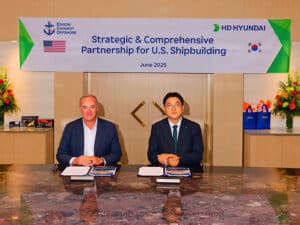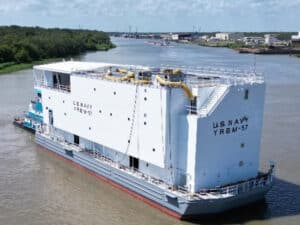
Austal reports loss-making half year
Written by Low activity levels at its Henderson, Western Australia, shipyard pushed Austal Limited into a first half operating loss of Australian $ 6.3 million. That compared with a A$19.4 million profit for the corresponding prior half year.
Low activity levels at its Henderson, Western Australia, shipyard pushed Austal Limited into a first half operating loss of Australian $ 6.3 million. That compared with a A$19.4 million profit for the corresponding prior half year.
The half yearly results for the year ended December 31, 2011, released February 24, also reflected weak operating results from its U.S. operations which were impacted by the start up challenges of producing the first Joint High Speed Vessel (JHSV) which will be delivered later this year.
The loss came despite a nearly 50 percent increase in revenue from Austal’s United States operations compared to the corresponding period last year. This growth is anticipated to continue, with further large contracts expected to substantially boost the existing order backlog which stands at approximately A$2 billion.
Overall revenue increased by A$16.3 million over the corresponding prior half year period to A$267.4 million.
The operating loss was driven by low activity levels in the Australian business and a weak operating result from the US operation. The operating loss resulted in the breach of a banking covenant which, pursuant to applicable accounting standards, required the reclassification of the group’s long term debt to current debt. The breach was waived by the group’s banks paving the way for the reversal of the reclassification in the next reporting period.
The U.S. currently accounts for approximately 85 percent. of Austal’s revenue.
Referring to the high start-up costs of the JHSV, Andrew Bellamy, Austal’s Chief Executive Officer, said: “As is common with new, complex naval vessel designs, first of class effects adversely impacted productivity resulting in the vessel being well behind budget,” said .
“With the design now mature, and lessons learned from the first vessel being successfully applied, productivity on subsequent hulls has improved by approximately 35 percent,” Mr. Bellamy said. “This has resulted in substantial cost savings, which bodes well for the ships to follow.”
Austal said it currently had confirmed orders from the U.S. Navy for seven JHSVs and three Littoral Combat Ships (LCSs). Contract options for three JHSVs and eight LCS were still to be exercised at the date of the half yearly report. However, that same day the U.S. Navy exercised its options for the eighth and ninth JHSV’s (see earlier story).
“Both the LCS and JHSV programs are now into series production, which will really enable us to derive schedule and cost efficiencies from our facilities investments including the purpose-built Module Manufacturing Facility which brings assembly line techniques to aluminum shipbuilding,” said Mr. Bellamy.
Mr. Bellamy said that Austal was successfully executing key strategies that had been rigorously developed over a long period to counter long term changes in economic and market conditions affecting other parts of the business.
“It was clear to us for some time that continuing to build commercial vessels in Australia was not a viable long term strategy and we took the difficult decision to move production of those vessels to the Philippines,” he said.
“We have recently been successful in winning commercial vessel work for the Philippines shipyard operation, and this facility will continue to be instrumental in regaining our competitiveness in international commercial markets
“We have focused the Australian operations on the manufacture and support of defense vessels and had early success, winning the A$330 million contract for eight new Cape Class Patrol Boats for the Australian Customs and Border Protection Service in August last year,” Mr Bellamy said.
“We are currently pursuing other defense opportunities around the world that would be built in Henderson.”
The Cape Class Patrol Boat contract, which includes options to support the fleet for up to 20 years, is also central to growing Austal’s international service business. Compared to the corresponding previous half year period, that sector’s pre-tax profit rose by 20 percent with revenue from external customers increasing by 13 percent.
February 27, 2012



![NOAA Ship Oscar Dyson working in the Bering Sea in Alaska. [Photo: NOAA Marine and Aviation Operations/CDR Carl Rhodes]](https://www.marinelog.com/wp-content/uploads/2025/06/blobid1_1750193597078-300x225.jpg)

Leave a Reply
You must be logged in to post a comment.